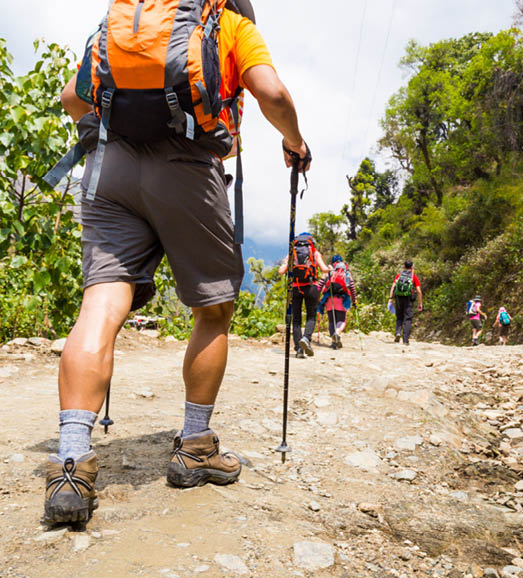
If you are new to bushwalking or haven’t hit the track much lately (yeah, yeah, COVID), then you are probably wondering if you’re fit enough to tackle a bushwalk, let alone an overnighter.
Some comfort. You don't need to be buff to hit the track, but the fitter and more prepared you are, the more you will enjoy it and the while reducing the risk from injury. Of course, fitness takes time to build, so don't try to rush it. Fitness is best built by doing what you need your fitness for, so walking is a great way to get fit for walking.
Bushwalking Fitness
Text Matt McClelland



40 | Bushwalk August 2022
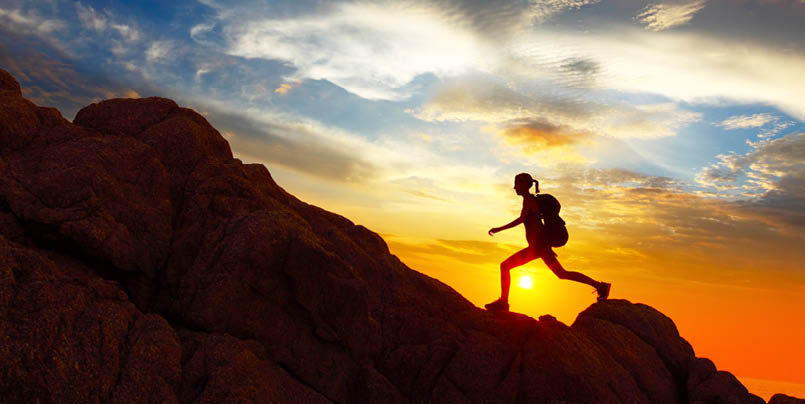

Most articles on track fitness talk about hitting the gym and doing a wide range of complicated exercises. There may be a place for the gym, but let's face it, people have been walking this Earth very effectively for tens of thousands of years, well before the idea of gyms was considered. The best way to get fit for walking is by walking. Yes, there are some things we can do to help build that fitness more efficiently, to recover from injury, but whatever you do, it needs to be motivating. Doing something is way better than a fancy plan that is not implemented.
What is fitness?You would think it would be easy to define, but gee wiz, it can get complicated. For the sake of this article, let's think of fitness more as medical people do - “one's ability to execute daily activities (bushwalking) with optimal performance, endurance and strength with the management of disease, fatigue, and stress.”
Too often is fitness defined very narrowly - focused on cardio or specific muscle strength. But there is no point in having a very powerful engine if your tyres are flat and linkages are rusty.
If we were to take this article to its full extent, then fitness could be defined more like “able to fulfil a particular role or task”. This would cover a much broader range of requirements, including skills, funding, knowledge, and nutrition. These are obviously important to undertaking any walk, but the article would soon turn into a novel.
So for the sake of this article, let's think about preparing our bodies for a big walk, being able to enjoy walking efficiently while reducing the risk of significant injury.
Know your fitness and goalsStart by thinking about where you are at and where you want to get to. Consider your past injuries, activity levels, nutrition, motivation, budget (time and money), medication and illnesses. Once you know your starting point you can set realistic goals. What areas of fitness will you need to work on to achieve those goals? How much time and money are you willing to invest? If you have any significant medical issues or a number of minor ones, consider speaking to your GP or an Exercise Physiologist/Physio to get a personal plan. An hour appointment can save you significant setbacks.
41
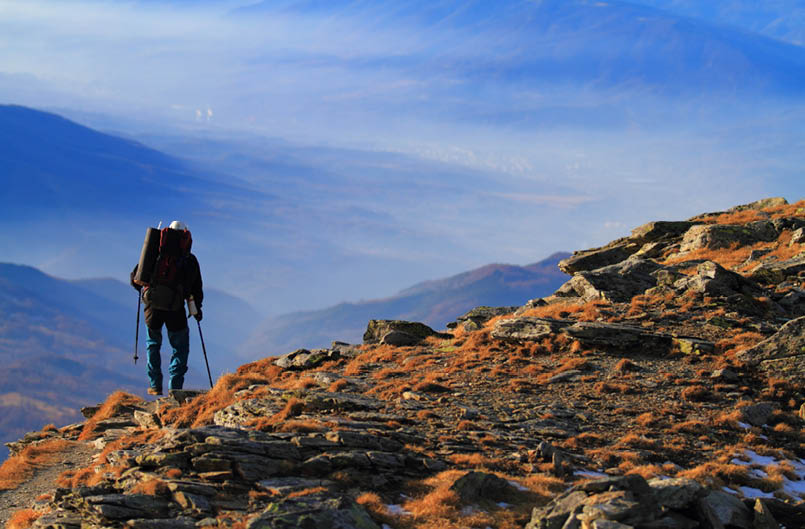

I am not suggesting you need to overthink this stuff. Your plan will depend on your goals and your starting point. If you have sat on a couch for the last year and are planning a two month bushwalk through rough terrain, then clearly more planning (and training) is needed than someone who walks regularly and plans an easy overnight walk.
Your goal is key, and your plan is just the tool that gets you to your goal. The plan should and will change. Stay flexible. If your plan is not motivating or working for you - change it! The first plan will not be the optimal one for you. As you learn more about yourself, your body, your goal and your motivation, you will be able to improve your plan. Are you a social person? Make sure your plan involves friends or groups. Is life a bit unpredictable for you? Maybe skip groups and plan activities that can be easily changed, like parking further from work or getting off the bus a bit earlier.
What kind of fitness do I need?There are a few key areas of fitness that will help you enjoy your walks. Rest assured that most walks do not require a very high level of fitness, but the fitter you are, the less you will need to worry about your body on the track. This fitness can only be built with time. Doing targeted exercises a couple of times a week should strengthen your body to the levels needed for an overnight walk without feeling exhausted. The main areas of focus include:
Agility (ability to traverse uneven ground)
Back and core
Shoulder and upper back
Feet/ankles (muscle and skin)
Leg strength
Cardio
Psychological strength (ability to just keep going)

42 | Bushwalk August 2022
Agility
Agility is often overlooked in training but is really important. Think mountain goats - the ability to move across rough terrain with greater ease. We spend so much time on smooth flat surfaces; agility is a skill easily lost. Start on surfaces where you know you won’t trip or fall, and build up to more uneven terrain over time. Don't try improving agility and core at the same time; this will end in tears. Maybe try taking turns standing on one foot when waiting in a queue. When you feel safe, start avoiding smooth surfaces like footpaths and build up roughness over time.
Walk on soft sandy beaches or grass.
Stand on one foot. When you feel confident, try picking up something from the floor or seeing how far you can reach out with your other foot.
Walk along narrow beams that require balance (like a line on the floor, road gutter edge, or low logs at the park).
Step over things - gutters, logs, low barriers, even just clutter! Nearer to the big walk, try this with your pack on.
If balance and agility continue to be a challenge, maybe try out some walking poles.
Jump! Start with something easy for you, even if this is simply bouncing from foot to foot. Jump between marks on the ground and build up to short jumps between rocks.
Agility on track will improve with strength, but a lot of it is learned. It is your brain deciding where and what angle to place the foot to get stability and flow, like learning to balance on a bike. It takes a lot of focus at first, but then soon we don’t even think about it. It’s hard to remember that you needed to learn
it. Walking becomes much more enjoyable when agility becomes subconscious. Practise deliberately, often and safely, and it will become subconscious.
Back and core (also shoulder and upper back)
Strong back and core muscles will help you make the walk with a backpack more comfortable and easier to do. The goal is not rock-hard abs, rather improving control and coordination will take your walking much further. Walking in a pool is a great way to start. The water supports your body but provides lots of resistance. When you feel a bit stronger, put on a pack and go walking. Build up your pack weight slowly (maybe about three kilograms a week. Think water bottles - you can empty them if needed).
Walk in water, at least waist-deep - forwards, backwards, as fast as comfortable.
Start adding weight to your pack by re-using soft drink bottles filled with water.
Find a nearby walk with lots of stairs - walk up and down while keeping good posture.
Do your regular food shop using your hiking pack and walk home.
Walk to work/school/bus stop carrying your pack.
Walk deliberately, holding good posture. If you find it too hard to maintain a good posture comfortably, lose some pack weight or some distance and keep practising. Carrying weight alone does not build the core - you need to be able to stabilise your core with the weight. People talk about setting your tummy muscles - this is not as easy as it sounds and is worth getting some guidance from a professional. Otherwise, focus on a good posture and build up the pack weight slowly.



"
Strong back and core muscles will help you make the walk with a backpack more comfortable and easier to do.



43

Feet and ankles
Your feet are your contact with the ground. Strong feet and ankles give a strong foundation for walking. But your feet also tell your body what's happening with the ground beneath you (known as proprioception). If you’ve ever sprained or broken an ankle, this is something you will want to build up slowly but surely (see the section on agility). Build up time on your feet - standing and walking, especially on uneven surfaces.
Consider minimalist shoes if your feet are already strong and only where comfortable. Maybe just start by walking around the home for five minutes barefoot. Be careful not to cause a foot injury (stepping on glass etc.). Time with minimal shoes will help make your skin tougher.
Finally, get plenty of time walking in the socks and footwear you plan to use on the track. New shoes are a nightmare on the track, and shoes that haven’t been worn for some time can delaminate after a few days. Toughen your feet for your footwear, and if you start to develop a hot spot, stop and manage it don’t let it turn into a blister.
Heel raises help strengthen your calf muscles. Do a heal raise by standing with your feet about shoulder width apart then slowly raising your heels off the floor, keeping your knees straight, hold for about six seconds, then slowly lower your heels back down. Hold onto something sturdy to help balance.
Legs and cardioThese two go hand-in-hand when we’re training for a walk. You might focus more on the strength at times and other times on the cardio (think: puffing). If you have any conditions that affect your heart, lungs or legs, then professional guidance is strongly recommended.
Do a few heel raises whenever possible (in the kitchen, in the elevator or waiting in a queue - be sure you have support as needed). Be sure to lower your heels slowly - can you stop halfway? Practice holding it for a few seconds, or even rise up on just one foot. Build up the number you can do.
Walk on sandy beaches.
Walk around barefoot or with minimally-supportive shoes, being sure they still fit well, so you don’t trip!
Try walking with wet socks and footwear at times. Make the most of puddles, but be sure to dry everything thoroughly afterwards.
As a general rule, start small and build up gradually. Aim for “moderate intensity” - you should be able to talk but not sing! Do not rush this, it's a hare and tortoise game. The biggest mistake we make is trying to do too much too soon, bringing on injuries and taking the joy out of it. Try to make your training fun, a chance to spend time with friends and in nature.
Lunges help strengthen your many big muscles in your legs and lower back. Do a lunge by standing with your feet about shoulder width apart then step forward longer than normal. Your foot should land and stay flat on the ground. Your heel (behind you) will rise off of the ground as you bend your knees to about 90 degrees. Keep your body upright with good posture. Then, push back with your front leg to return.
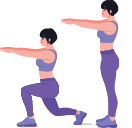
"
The biggest mistake we make is trying to do too much too soon ...











44 | Bushwalk August 2022
Walk on land or in a pool (sandy beaches and rivers are great too).
Sit to stand (stand up from a seat, trying not to use your hands).
Lunges (but do them correctly).
Step climbing (up and down).
As your fitness improves, try picking up the pace or talking as you go to improve things further. Think about the highest hill you will climb on your planned walk. Practice a similar height gain near home - you might need to yo-yo your local hill a few times.
Psychological strengthLong-distance walking is more enjoyable with better head space. Yes, psychological strength is really a part of fitness. I know most talk is on muscle fitness, but the right headspace makes a profound difference to performance. Most of us think we are strong mentally; after all, it's just a walk. Much of our resilience comes from the people around us, but developing grit is also helpful. You can develop grit by learning to enjoy more extreme conditions, like being comfortable in rain, colder weather and wind. Learn to use your rain gear and practise using it. Being diligent with your training is a great way to start. Don't create a crazy schedule - be realistic and then stick at it. And when it is possible, train with your walking buddies. Some exercises that will help you build your mental strength and prepare you for different types of situations are:
Get out on some longer day walks before doing some overnight walks.
Don’t skip the days when it’s raining or it’s cold - use it to train yourself up.
Practise walking in uncomfortable conditions, such as with wet socks, boots and pants.
Even try eating lunch in a cold shower with your rain gear.
Pitch your tent under a sprinkler at night.
Walking polesThere are lots of interesting programs that use poles for building fitness. When it comes to bushwalking with poles, they are generally intended to make walking easier and safer. Using poles well takes good technique and practice. Poles can lead to severe injury and may make walking harder. Hand, wrist and shoulder injuries are not uncommon, let alone the occasional impalement. Do your research into how to use your poles. Think about hand grip, straps, height, placement and when to apply pressure in different situations. If you are going to use poles, then learn how to use them and practise training your body and brain, similar to agility training.
Learn how to set your pole height, grip and placement (for different terrain).
Walk with your poles often, deliberately practising the correct use.
"
You can develop grit by learning to enjoy more extreme conditions, like being comfortable in rain, colder weather and wind.



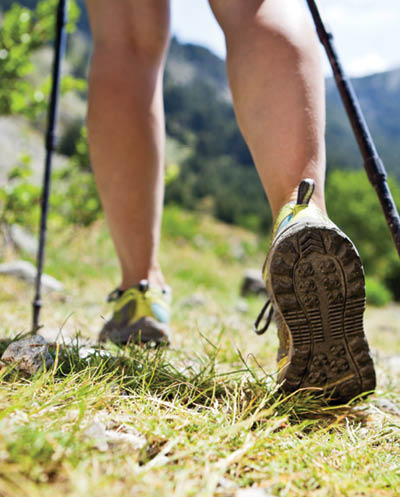
45
Pace yourselfThe best advice when it comes to building fitness is to pace yourself. Building muscle strength literally requires the breaking of tiny fibres, which your body then rebuilds stronger. All kinds of fitness need to be built up, and they can’t be rushed. This stuff takes time, so plan to make it fun. Pace your training around what is enjoyable and part of your day-to-day routines. Maybe park further and further from work. Instead of a big shop once a week, do a few small ones and carry your supplies home in your overnight pack. Better still, gather your friends and hit the local bushwalking tracks, even if that means starting on smooth and flat tracks. Build it up over time, and if you enjoy it, you are more likely to stick to it.
Part of pacing is not to do intense exercises every day. Give your body time to heal. If you’ve had a big hard day, give your body a day or two to heal and grow. Be deliberate in your training. This is part of the reason a plan is so helpful.
Have a plan with weekly goals.
Each week, check your progress.
Tweak the plan to match your life, motivation levels and fitness goals.
No pain, no gain?We have all heard the saying “No pain, no gain”. Is it true? Not really. Forget what the gym junkies tell you - you are planning for a bushwalk, not a bodybuilding competition.
Low-level soreness is usually okay, but pushing through a “pain barrier” will usually make things worse - much worse. If you are with a trained health professional, there are times for pain, but it is usually not a healthy way to approach building fitness for most people.
Pain is (usually) a very helpful thing. Hang on, didn’t I just say the pain was bad? Pain is your body's way of shouting that something
is wrong and compelling you to stop causing damage. It is an engine warning light that can not and should not be ignored. Pain is a good thing as it warns us of damage so we can adjust to reduce further damage. Pain tells us that something was too much.
Listen to painResponding to pain is really important to healthy bodies, just ask someone with leprosy - most of their deformities are due to a lack of pain sensation leading to horrific overuse. People with chronic pain are the exception to this rule. Their engine warning light is stuck on even when there is nothing causing damage. People with chronic pain will benefit from professional support to train effectively and reduce risks.
Pain often comes from things like big tears, breaks, heart muscle injury or other really nasty things that need urgent medical attention. The build-up of lactic acid, cramping and muscle fatigue can also cause significant pain.
However, soreness tends to come from things such as mild inflammation or micro-tears in muscle or other tissue. Microtrauma sounds bad, but it is actually what triggers growth and strengthening, rebuilding with more individual muscle fibres. It also helps build callous on the skin. Soreness is common if you start doing something new or return after a longer break. The soreness will usually ease once you rest for a while.
I know this all sounds subjective. Err on the side of caution. If you think you might be doing damage then back off. You can’t unscramble an egg - pace yourself.
Delayed onset muscle sorenessAs the name suggests, delayed onset muscle soreness (DOMS) is a generalised soreness (or stiffness) that lasts for a few days and can take a few days to start after more intense
"
... you are planning for a bushwalk, not a bodybuilding competition.







46 | Bushwalk August 2022


exercise. DOMS is usually made worse from exercises that cause your body to contract muscles whilst your movement lengthens the same muscle, such as running downhill or walking downhill with a heavier load.
DOMS is caused by the release of enzymes that actually help repair tears in muscle fibres.
Your body will fix DOMS in a few days. Also, DOMS is a kind of cure; it is a result of your body's healing. DOMS is not a sign of poor fitness, it is just a sign of specific muscles doing more than they are used to. Muscles are very specific. This is a big part of why the best training for walking is walking.
If your DOMS is mild, you can do gentle exercises and stretches. Otherwise, let it pass before you start to build up your fitness training again. It seems that pacing and not rushing is the key.
DOMSPeople will tell you DOMS is a build-up of lactic acid, but that is something very different. Lactic acid actually builds up quickly when your muscles don’t get enough oxygen and goes away within a few hours with rest. DOMS last for days and starts well after this.
But let's be clear, DOMS is not the goal. If the DOMS impacts your day-to-day activity, it is too much. In fact, significant or lasting soreness can actually work against you. A little soreness is to be expected, but more is definitely not better.
When you hit the trackRarely are we as fit as we want to be when we hit the track, life happens. If you can plan the first day or two of your adventure to settle in and help build fitness, that is great. Try to plan shorter days and fewer hills at the start of your journey. If you have a longer walk planned, then consider rest days each week and maybe two in the first week. Don’t use this as an excuse not to train but just consider how you pace your preparation and trip. After all, this is meant to be fun.
At the end of the day, bushwalking is meant to be enjoyable, and it is so much better if the preparation is too. Don’t feel the need to hit the gym unless you have specific injuries that require it. Instead, get out and do what you enjoy with a plan to build your fitness to meet your goal. Build all areas of your fitness. It is not all about cardio or core. If you need advice, book time with a health professional and avoid the well-meaning (and buff) gym junkie’s advice. Hit the track, take care, pace yourself and have fun.
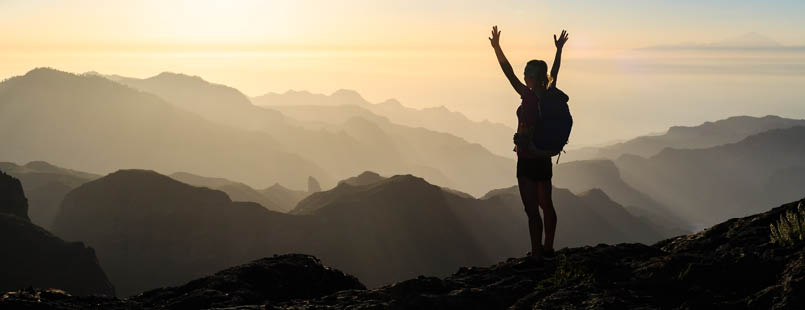





47